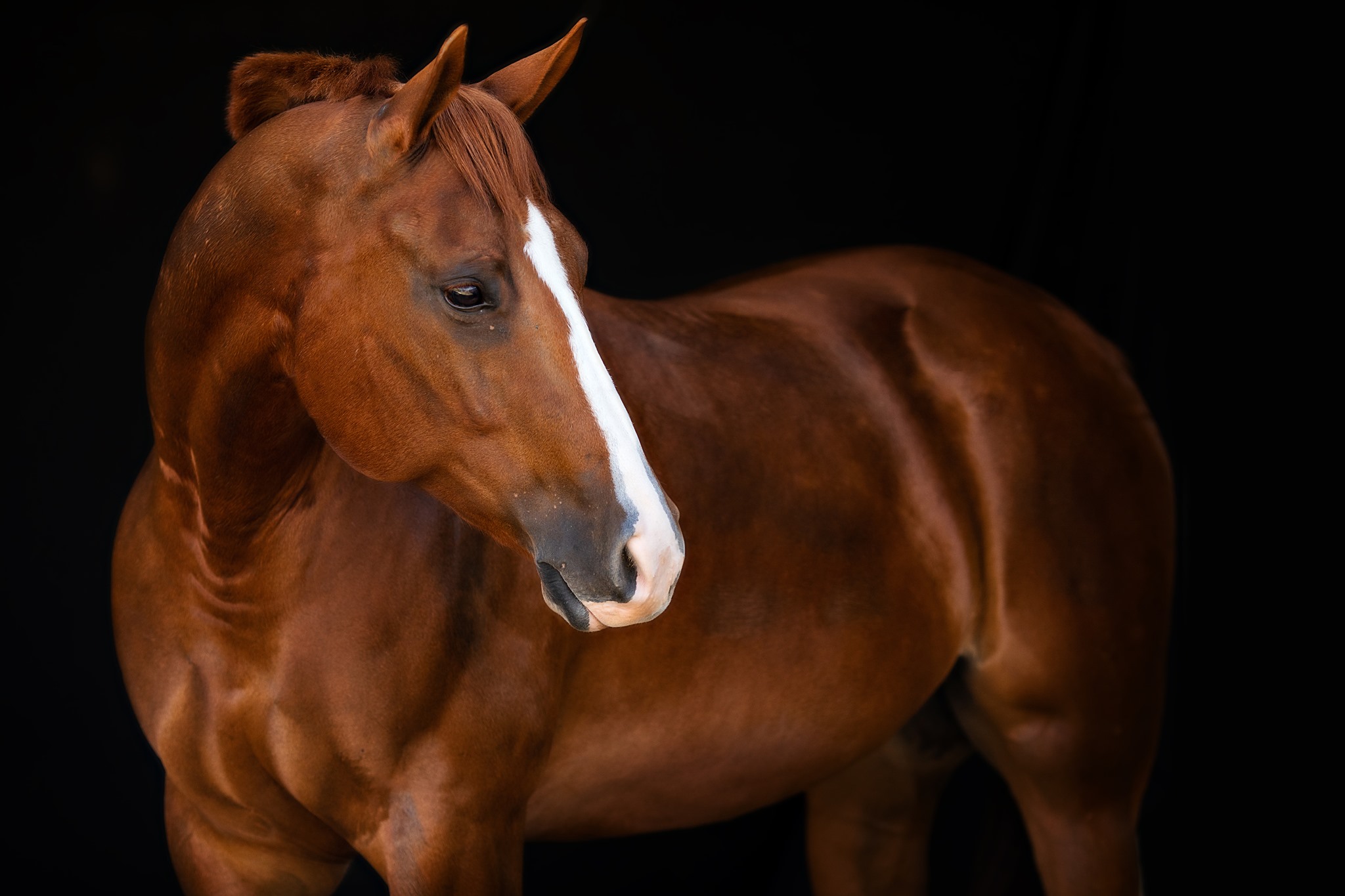Shivers in horses is a neurological condition that can affect horses, primarily characterized by involuntary muscle spasms and tremors, particularly in the hind limbs. This condition can be distressing for the horse and their owner, as it can impact the horse's mobility and overall well-being.
Thanks to the latest advances and research breakthroughs, horse owners and veterinarians have a better understanding of what this neurological condition entails. Shivers has been widely acknowledged in horses for hundreds of years, and the equine community now knows more about this condition than ever before.
Let’s take a look at some of the critical aspects of Shivers in horses, what the clinical signs are, the impact it has on affected horses, and how you can manage this condition in your equine.
What are Shivers in Horses?
Shivers in horses is a progressive and chronic neurological condition or "movement disorder" affecting an equine's ability to walk backward. This ailment is classically characterized by an abnormal gait in horses when backing up.
Signs of Shivers can usually begin before five years of age. Breeds most often affected by this syndrome are draft horse breeds, warmbloods and occasionally lighter breeds including light harness horses, hunter jumpers, Quarter Horses and Thoroughbreds. There is no cure for Shivers, understanding it better and knowing how to manage it can help your horse potentially lead more a more comfortable life.
Which Equines Develop Shivers?
The exact cause of Shivers is currently a subject of ongoing research. While there is no single known cause, several potential contributing factors can definitely advance the understanding of Shivers in horses.
Genetic Predisposition
You might find Shivers in horses more prevalent when it comes to certain breeds of equines. There is no specific genetic pattern or genetic test for shivers, but some breeds might have a higher incidence of Shivers.
Age
Horses are not born with this neurological condition but may develop as early as two years of age, although most cases develop between six to twelve years. If a horse is going to develop Shivers, it will usually have appeared by the time they are ten years of age, although it can occur in younger or older horses as well.
Neurological Abnormalities
Shivers can also occur in equines due to abnormalities in the horse's central nervous system or peripheral nerves. Research suggests that an abnormal accumulation of certain proteins in the brain or spinal cord could be involved in developing Shivers.
Height
Shivers is more typically seen in taller horses, such as warmbloods, draft horses, and thoroughbreds. This condition is rarely seen in ponies.
Gender
It is said that geldings are much more likely to be affected by Shivers than mares. This tendency could be height-related, but it could also be due to the protective effects of estrogen.
How Do Shivers in Horses Develop & What are the Causes Behind It?
The causes behind Shivers in horses are still not understood. Still, scientists and experts have been able to narrow it down to a particular area in the brain that suffers from nerve damage and, therefore, does not function properly.
The affected area of the brain is known as the cerebellum or "little brain" that is responsible for posture, coordination, and balance. Neurons in this part of the brain modulate learned muscle movements, including lifting the hindlegs and backing up.
It is important to remember that Shivers is a multifaceted condition, and not all neurological disorder cases present similarly. The severity of the condition varies from horse to horse.
What are the Signs of Shivers in Horses?
Shivers in horses is characterized by a distinct set of clinical signs and symptoms that primarily involve the hind limbs and sometimes even the tail. Shivers tend to develop gradually in equines, but the onset of symptoms can vary from horse to horse.
Signs of shivers become apparent after your horse has rested or remained in their stall for a period of time or while walking in tight circles. Other common signs of shivers in horses include:
Involuntary Muscle Spasms: This is the hallmark sign of shivers in equines. Involuntary muscle spasms, typically in the hind limbs, often manifest as rhythmic, hyperflexion movements.
Tail Elevation or Curling: Muscle spasms can also affect the muscles in the tail, leading to tail curling or elevation.
Shivering Movements: Horses suffering from Shivers may exhibit shivering or trembling movements in their hind limbs when asked to perform specific actions. This might be especially noticeable when the equine is asked to lift their hind limbs for trimming hooves or cleaning.
Coordination Difficulty: Horses that have been afflicted with Shivers may face coordination difficulty, especially in the hind limbs, making it difficult for them to perform certain movements with precision.
Movement Difficulty: Horses may experience difficulty in movement when struggling with Shivers. This movement struggle may involve difficulty while lifting the hind legs, such as backing up, stepping back into a trailer, or even standing still.
Symptoms During Rest: Signs of Shivers in horses can sometimes be more pronounced during periods of rest when the horse is asked to stand quietly, notably when the weight is shifted from limb to limb.
Gait Characteristics: You can also recognize Shivers in your equine by carefully observing and detecting two abnormal gaits.
Hyperflexion: Where one hind leg is suddenly jerked off from the ground and held away from the body in a flexed position for several minutes while the leg shakes and trembles. This could be accompanied by an erect tail that also trembles and Shivers. Once the episode is over, the leg is returned to the ground.
Hyperextensions:Where the horse extends the hock and stifle joints by placing both hind feet farther than normal when backing. Your equine's heels might also completely come off the ground. The horse places both front feet farther out in the front, leading to a "sawhorse" stance with all four legs. This position makes it extremely difficult for the horse to back out.
Diagnosis of Shivers in Horses
Shivers can be difficult to detect in its early stages as the symptoms might be mild to intermittent initially. Repeated observations and a complete veterinarian evaluation can help identify the problem.
As a horse owner, it is vital that you document all your observations while a vet conducts a complete examination, including a lameness evaluation, along with other possible diagnostic testing such as blood work, imaging, and biopsy. By noting when episodes occur, what happens just before your equine depicts signs, and if anything has changed recently in the horse's routine such as diet, housing, stress levels, or exercise, you may be able to determine an emerging pattern. Combined with veterinary testing, this can help rule out other conditions and diagnose Shivers.
Other diagnostic signs that your vet can look out for include:
- Hyperflexion of the leg in motion
- Aversion to a handler lifting up the hindlimb in a flexed position (e.g., to clean the hoof)
- An inability by your horse to walk backwards
- Atrophy of thigh muscles in advanced Shivers cases
Keys to Helping with Equine Muscle Support & Recovery
Optimal equine muscle health and adequate support and recovery of the muscular system can play a helping role in dealing with Shivers in horses. You can consider adding supplements containing selenium, amino acids, Vitamin E, and branched-chain amino acids to help support muscle function and recovery.
Based on research, the following ingredients may lend support to your horse's muscle health and function:
Vitamin E: Fat-soluble vitamin containing antioxidant properties that help protect cell membranes from oxidative damage, maintaining muscle functions and reducing the risk of muscle disorders.
Selenium: A trace mineral that acts as an antioxidant in the body and protects cells from oxidative damage that can occur during strenuous muscle activity or exercise.
Amino Acids: Building blocks of proteins that are essential for muscle growth and repair, muscle protein synthesis, and recovery after exercise.
Branched-Chain Amino Acids (BCAAs): Include leucine, valine, and isoleucine, which are essential for muscle maintenance, repair, and recovery, especially in performance and working horses.
It is important to do thorough research and consult with a veterinarian before deciding on a nutritional plan for your horse. Make sure to keep in mind your horse's age, breed, and overall health status. Revise and update the nutritional plans annually to accommodate alterations in exercise, dietary requirements, health status, and other variables that can impact overall health and performance.
How to Manage Shivers in Horses
Unfortunately, there is currently no successful and effective treatment or cure for Shivers in horses. This degenerative neurological condition worsens over time, irrespective of the care or treatment administered to your horse. In mild cases of Shivers, affected horses can continue to participate in leisure activities or athletic disciplines for several years before retiring completely.
Experts and veterinarians recommend managing the signs through a combination of exercise and turnout, nutritional support, and other special considerations that can help make life more comfortable for horses suffering from Shivers.
Nutritional Support
All horses require a balanced forage-based diet that provides adequate energy, vitamins, and minerals to meet their nutritional needs. Avoiding nutritional deficiencies in horses with shivers is especially important to support optimal muscle health and a strong nervous system.
Exercise
Maintaining a consistent exercise routine for your equine can help in maintaining muscle mass and reduce the signs of Shivers. Giving your equine a long break from exercise, such as after the competition season or over the winter, or stalling due to an injury, can lead to muscle atrophy and worsen the symptoms of Shivers in horses.
Special Considerations
Other special considerations can be kept in mind when dealing with Shivers in horses. Experts claim that stress and excitement tend to worsen the symptoms in horses afflicted with Shivers. As a horse owner, learning what stresses or excites your equine and avoiding exposure to those elements would be advisable.
Pay attention to regular hoof care, as it can be challenging to hold the hind leg at one angle for a long time for the same. You can use the following tips to clean your horse's hooves if they suffer from Shivers.
- IV sedation by a vet can reduce the symptoms long enough for you to administer complete hoof care.
- You can use hoof stocks, stands, or slings to assist with holding up the foot.
- You can stand your horse in the sand so that the hoof can be cleaned by digging out a hole in different parts around the hoof to allow cleaning and trimming.
Conclusion
There is currently no specific cure for Shivers in horses. Management strategies for this condition focus on providing affected horses with a well-balanced diet, a low-stress environment, and a consistent routine that can help improve the quality of your equine's life. Vets and equine specialists can offer guidance on managing shivers and addressing the specific needs of the affected horse.
The good news is that extensive research into this condition has made multiple advancements in the last few years. Further study into what causes the clinical symptoms (cerebellar tissue degeneration) may help us better understand what could potentially prevent and treat those signs.


